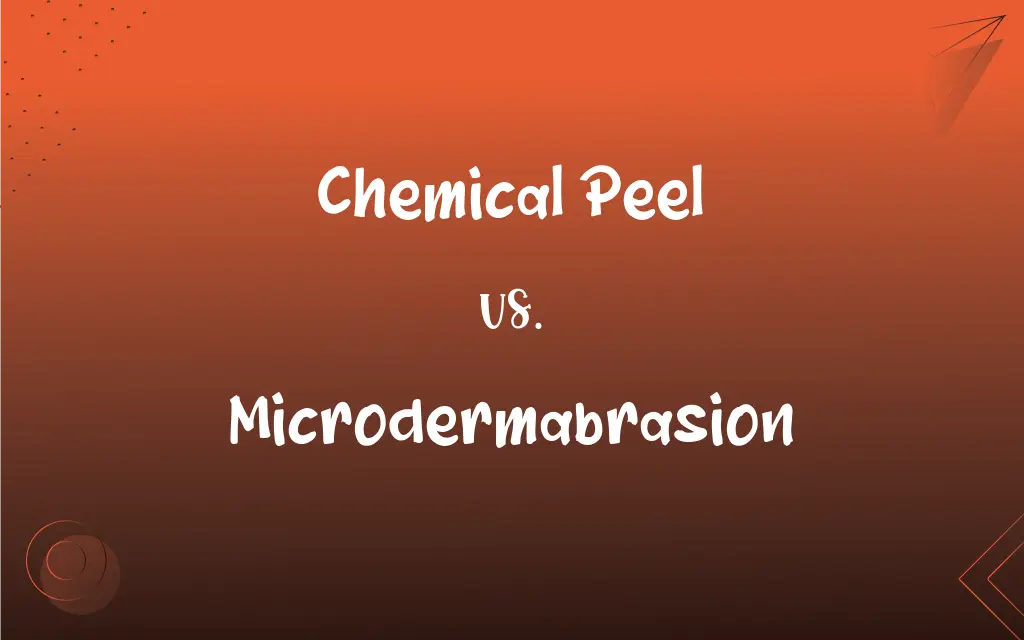Chemical Peel vs. Microdermabrasion: What's the Difference?
Edited by Aimie Carlson || By Harlon Moss || Published on April 19, 2024
Chemical peel uses acids to remove skin layers, improving texture and tone, while microdermabrasion mechanically exfoliates the skin's surface for rejuvenation.

Key Differences
Chemical peels involve applying a chemical solution to the skin, causing the top layers to peel away, revealing smoother, more youthful skin underneath, whereas microdermabrasion uses a physical exfoliation technique that sands away the outer layer of skin to rejuvenate and brighten the complexion. Both treatments aim to improve the skin's appearance but do so through very different methods.
Chemical peels can range from mild to deep penetration, affecting not only the surface but also the deeper layers of the skin, microdermabrasion primarily focuses on the superficial layer of the skin, making it a less invasive option. Chemical peels are known for addressing issues like deep wrinkles and sun damage, whereas microdermabrasion is often used for more surface-level concerns such as light scarring and fine lines.
The recovery time from a chemical peel can vary greatly, from a few days to several weeks, depending on the intensity of the peel, while microdermabrasion typically requires minimal to no downtime, allowing for a quicker return to daily activities. This makes microdermabrasion a popular choice for those seeking a less disruptive skincare treatment.
Chemical peels are often chosen by individuals looking to address specific skin conditions such as hyperpigmentation, acne scars, or more significant signs of aging, while microdermabrasion is frequently selected for its ability to enhance skin texture and tone with less risk and discomfort. Both treatments offer valuable benefits, but the choice between them will depend on the individual's skin type, concerns, and desired outcome.
Given the potential for stronger reactions and the need for a more careful post-treatment regimen with chemical peels, they are typically performed by or under the supervision of a dermatologist. In contrast, microdermabrasion can often be performed by a wider range of skincare professionals, including aestheticians, making it more accessible for regular maintenance.
ADVERTISEMENT
Comparison Chart
Method
Uses chemical solutions to remove skin layers
Uses physical exfoliation to sand away the outer skin layer
Depth of Treatment
Can vary from superficial to deep
Primarily superficial
Target Concerns
Deep wrinkles, sun damage, acne scars
Light scarring, fine lines, and minor skin texture issues
Recovery Time
Ranges from a few days to several weeks
Minimal to no downtime
Frequency of Treatments
Often less frequent due to deeper skin penetration
Can be done more regularly due to its non-invasive nature
ADVERTISEMENT
Ideal Candidates
Individuals with specific skin conditions needing intense treatment
Those seeking mild rejuvenation with less risk and discomfort
Chemical Peel and Microdermabrasion Definitions
Chemical Peel
A skincare treatment using acids to deeply exfoliate and rejuvenate the skin.
After her chemical peel, her complexion appeared significantly brighter and smoother.
Microdermabrasion
Suitable for all skin types and colors, with no downtime required.
He was pleased to return to work immediately after his microdermabrasion session.
Chemical Peel
Involves a recovery period where treated skin peels away, revealing new skin.
She scheduled her chemical peel when she had a week off to allow for the peeling process.
Microdermabrasion
A non-invasive procedure that exfoliates the skin's surface for a smoother texture.
Her skin felt incredibly soft after the microdermabrasion treatment.
Chemical Peel
Often performed by dermatologists for safety and effectiveness.
Her chemical peel was carefully applied by a skilled dermatologist to ensure the best results.
Microdermabrasion
Utilizes fine crystals or a diamond tip to gently remove dead skin cells.
The aesthetician used a diamond-tip wand for her microdermabrasion to avoid irritation.
Chemical Peel
Varies in intensity from light to deep, tailored to specific skin concerns.
He opted for a light chemical peel to refresh his skin with minimal downtime.
Microdermabrasion
Enhances skin radiance and promotes the production of new collagen.
Following regular microdermabrasion treatments, her skin appeared more youthful.
Chemical Peel
Targets deeper skin layers to address wrinkles, scars, and pigmentation.
The dermatologist recommended a chemical peel to reduce her acne scars.
Microdermabrasion
Often used as part of a regular skincare regimen for maintaining skin health.
She included microdermabrasion in her monthly skincare routine for optimal results.
Microdermabrasion
A cosmetic procedure in which a very thin layer of facial skin is abraded with a high-pressure spray of crystals in order to diminish the appearance of fine wrinkles, discoloration, scars, and other blemishes.
Microdermabrasion
(medicine) Any of several related procedures in which the outermost surface of the skin is removed for cosmetic purposes
FAQs
What is a chemical peel?
A chemical peel is a skin-resurfacing procedure using a chemical solution to remove top layers of skin, revealing smoother, regenerated skin.
What is microdermabrasion?
Microdermabrasion is a non-invasive treatment that exfoliates and removes the superficial layer of dry, dead skin cells.
How often should you get microdermabrasion?
Microdermabrasion can be performed every 2-4 weeks for ongoing maintenance.
How often can you get a chemical peel?
Depending on the intensity, chemical peels can be done every 4-6 weeks, but deeper peels may require more time between treatments.
Can microdermabrasion remove blackheads?
Yes, microdermabrasion can help to clear out pores and reduce the appearance of blackheads.
Is a chemical peel painful?
Chemical peels can cause a burning or stinging sensation during the procedure, with the intensity varying by peel strength.
What can I expect after a chemical peel?
Post-chemical peel, expect redness, peeling, and flaking, which can last several days to weeks, depending on the peel depth.
Can chemical peels remove acne scars?
Yes, certain types of chemical peels can reduce the appearance of mild acne scars over time.
What is the recovery time for microdermabrasion?
Microdermabrasion has minimal to no downtime, with possible slight redness for a few hours post-treatment.
Can chemical peels cause scarring?
When performed correctly, chemical peels rarely cause scarring, though deep peels have a higher risk.
Who should not get microdermabrasion?
People with active acne, eczema, or rosacea should consult a professional before getting microdermabrasion.
Are chemical peels good for wrinkles?
Yes, chemical peels can improve the appearance of fine lines and wrinkles by removing older skin and stimulating new skin growth.
When can I wear makeup after microdermabrasion?
You can usually wear makeup the next day after microdermabrasion, but it's best to let the skin rest for a day if possible.
Who should avoid chemical peels?
Individuals with active skin infections, certain acne medications, or very sensitive skin should avoid chemical peels.
Does microdermabrasion hurt?
Microdermabrasion is generally painless, though some may experience slight discomfort or a scratching sensation.
Can I wear makeup after a chemical peel?
It's recommended to avoid makeup until the skin has healed completely, which could take several days to a week.
How should I care for my skin after microdermabrasion?
After microdermabrasion, keep the skin hydrated, use sunscreen, and avoid harsh products for a few days.
Is microdermabrasion safe for all skin types?
Microdermabrasion is safe for most skin types, but it's best to consult with a professional if you have sensitive skin or certain skin conditions.
Is microdermabrasion effective for wrinkles?
Microdermabrasion can help to diminish fine lines and improve skin texture, making wrinkles less noticeable.
How do I care for my skin after a chemical peel?
Post-chemical peel, follow your dermatologist's instructions, which may include moisturizing, avoiding sun exposure, and using gentle cleansers.
About Author
Written by
Harlon MossHarlon is a seasoned quality moderator and accomplished content writer for Difference Wiki. An alumnus of the prestigious University of California, he earned his degree in Computer Science. Leveraging his academic background, Harlon brings a meticulous and informed perspective to his work, ensuring content accuracy and excellence.
Edited by
Aimie CarlsonAimie Carlson, holding a master's degree in English literature, is a fervent English language enthusiast. She lends her writing talents to Difference Wiki, a prominent website that specializes in comparisons, offering readers insightful analyses that both captivate and inform.







































































